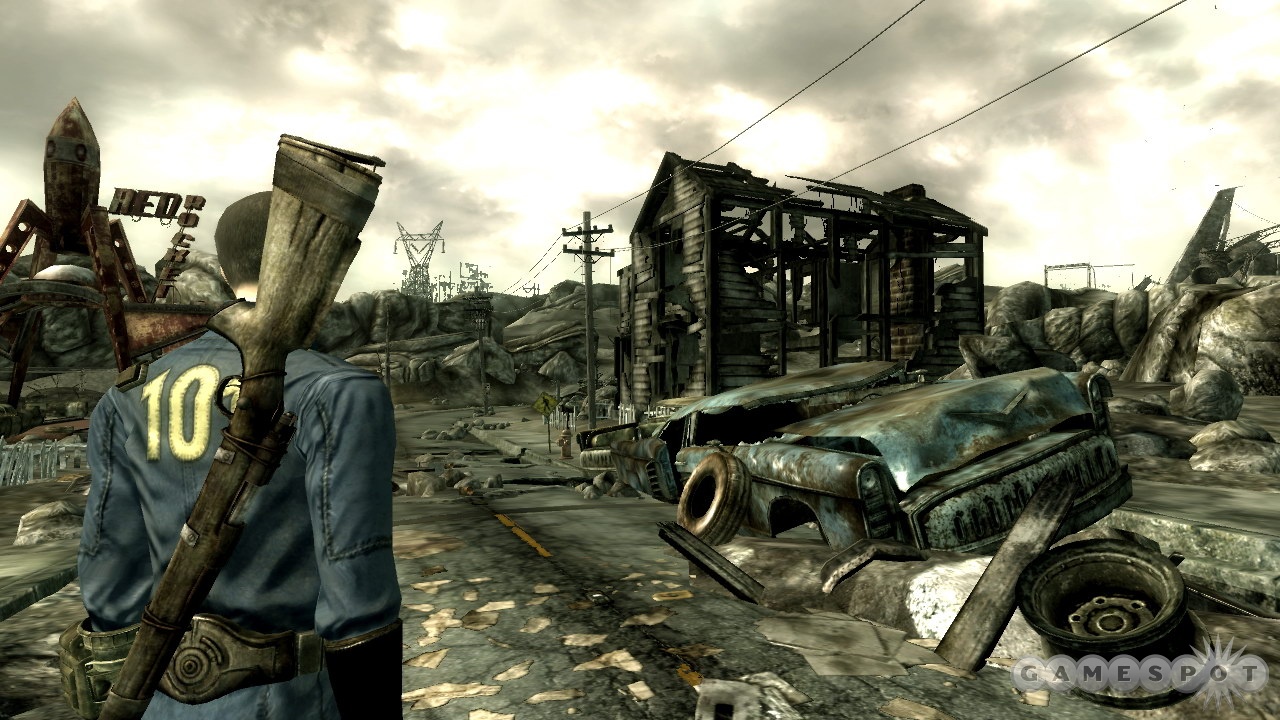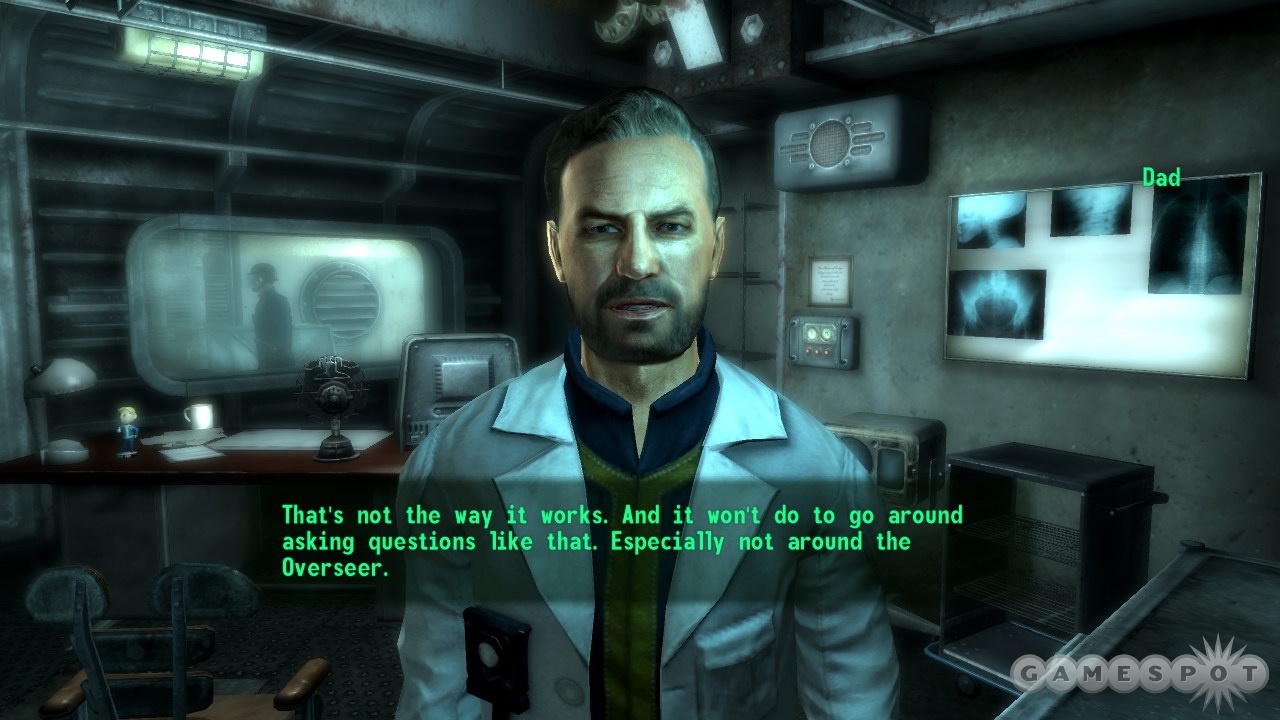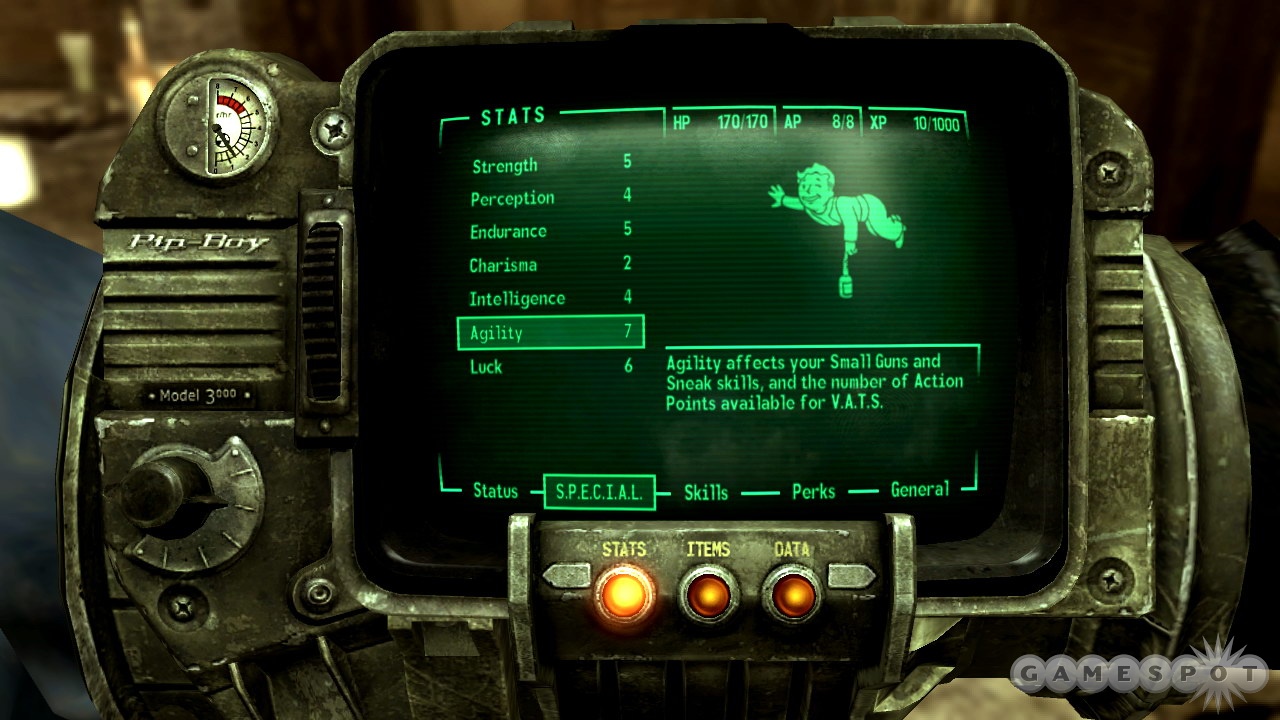Fallout 3 First Look - A Classic Series is Resurrected and Reimagined
After years of secrecy, we finally get a first look at the next big role-playing game from the makers of Morrowind and Oblivion.
Fallout. That name may not mean much to console gamers, but fans of PC role-playing games revere it. Published a decade ago by Interplay, Fallout became an instant classic by blending excellent role playing with a memorable setting and an ironic sense of humor. Fallout was followed by the equally popular and critically adored Fallout 2, but the series almost died along with Interplay's fortunes. That's when Bethesda Softworks, maker of the highly successful The Elder Scrolls series, swooped in to purchase the Fallout name and property. The result of that is Fallout 3, an incredibly promising and beautiful RPG that's set to arrive on the PC, Xbox 360, and PlayStation 3 next year. Bethesda has actually been working quietly on Fallout 3 for years, but the company finally opened its doors to show off the game, and we were there for a very first look.

The combination of Bethesda and Fallout may seem a bit strange. After all, Bethesda is known for first-person fantasy RPGs, such as the blockbuster hit Oblivion, which let you roam around pastoral lands armed with swords and sorcery. The Fallout games were top-down RPGs where you go around a nuclear wasteland armed with shotguns and assault rifles. However, Bethesda does have a history with postnuclear war games featuring guns (1995's Terminator: Future Shock was one of the very first first-person shooters with mouse-look), and executive producer Todd Howard explained that the folks at Bethesda have always been huge fans of Fallout. "It's the kind of game that we really love, in terms of [how] you make the kind of character that you want and then you do whatever the hell you want," he said. In fact, Howard said that the company had toyed with the idea of offering to make a new Fallout game when the sequels stalled at Interplay. When the opportunity to purchase the rights for Fallout came, Bethesda leapt at it.
First, here are some key basics about Fallout 3. Yes, it's a first-person game, but it also has a third-person camera if you like to play that way, and the camera can be moved so that it almost mimics the perspective of the original Fallout games. No, it's not a pure action shooter, though it can be played like a shooter in some ways, if you want. However, the game does rely on role-playing statistics to determine whether you hit or miss. More intriguingly, you can pause the combat at any time and target specific parts of an enemy's body, just like you could in the original Fallout games. And, yes, it's very much a role-playing game with hundreds of quests. While it only has a few hundred characters as opposed to the 1,500 in Oblivion, each of the characters in Fallout 3 will have his or her or its own distinct identity and dialogue. But we'll cover all of this in a bit.
Fallout 3 is set approximately 30 years after the events in Fallout 2, though knowledge of the first two games is not required. The world of Fallout isn't based on our own. Instead, it's the world of 2050 as envisioned by those in the 1950s and then blown up in a nuclear war with China. Your character's ancestors sought shelter in Vault 101, one of the many high-tech bomb shelters built by the Vault-Tec Corporation, which has the grinning Vault Boy mascot that doubles as the mascot for the game. Over the course of the next 200 years, the huge blast door to Vault 101 never opened. And it is into this underground city that your character is literally born. That's because character creation is cleverly tied into various childhood scenes, such as your birth, your 10th birthday party when you are given your Pip Boy (a computer that you wear on your wrist), and your 16th year, when you have to take the vault aptitude test to find out where your talents lie. When you determine the look for your character (you can play as either gender), you determine the look for your in-game father, voiced by Liam Neeson himself. He's the main scientist of Vault 101, and his mysterious disappearance will lead you to escape to the outside world in search of him.

When you reach the outside world, you'll find yourself in the blasted wasteland in and around Washington D.C., a departure from the American West seen in the first two games. This is an area teeming with wild creatures and rival factions, such as the Brotherhood of Steel, which defends the remnants the capital; the Slavers who occupy Paradise Falls, a converted strip mall; and the super mutants, tough-as-nails humanoids looking to take over. This world will be slightly smaller than the one in Oblivion, but that's still big. Where you go and who you ally with will be up to you because the game will have multiple endings. And yes, there will be a definitive end to the game, at which point you can start over to explore the many other choices. And Bethesda really wants to make choices count in this game, much more than it did in Oblivion. After all, in Oblivion you could pursue every quest in the game and be all things to all people. In Fallout 3, the choices will be much more binary, and they will have far-reaching consequences.
The example that Bethesda gave of this involves Megaton, a shantytown built around the worship of an unexploded nuclear bomb. When you arrive at Megaton, you'll eventually have two choices. A stranger will reward you if you rearm the bomb, as he represents a developer that would like to wipe Megaton from the map to make room for a nice postnuclear suburb. Or you can inform the town sheriff of the plot and save the town. If you choose to go along with the stranger, Megaton will be wiped out of existence in a glorious nuclear blast; thus, all the quests and adventures associated with it are gone. However, by blowing up Megaton, you'll open up a new area in the game that you would not otherwise have access to, Tenpenny Towers. But if you decide to save Megaton, you won't experience the quests and adventures associated with Tenpenny Towers. Talk about a tough call.
Regardless of what choices you make in the game, you'll need to fight for your life against foes, both human and mutated. As we previously noted, combat can be done in real time, just like in an action game. If that's the case, the game is still doing dice rolls, taking into account your character's skills and abilities, but that's all transparent to you. Or you can pause the action at any time and engage in traditional Fallout-style combat, using the Vault-Tec Assisted Targeting System. VATS allows you to use any action points that your character has to target enemies. Combat will then unfold in real time before pausing again. You can go even further and target specific portions of an enemy, such as crippling a leg or slowing an enemy down (useful if you don't want the foe anywhere near you). One example that we saw involved shooting the antenna off of a giant ant, thus blinding and confusing it to the point that it attacked nearby ants.

Fallout has always been known for its ridiculously over-the-top violence. For instance, if you fire a shotgun at point-blank range in the original game, bodies explode in showers of gore. As Howard noted, that tongue-in-cheek splatter is part of what made Fallout so much fun. And that's something that Bethesda is working to capture in Fallout 3. Heads will explode, limbs will get sawed off by gunfire, and we even saw eyeballs fly out of their sockets then roll down an incline. This will be the case especially if you have the infamous bloody mess character perk, which boosts the odds that each death you cause becomes a spectacular one. Bloody mess is just one of the many returning character perks from earlier games, though Bethesda is adding plenty of its own as well. Fallout fans will also be happy to know that the game retains the series' S.P.E.C.I.A.L. system, which builds your character around attributes (strength, perception, endurance, charisma, intelligence, agility, and luck); skills, which are things that you learn, such as repair skill; and perks, which are innate abilities. As you level up in the game, you'll have the opportunity to improve your attributes, learn new skills or improve existing ones, and add up to 10 additional perks to your character. In Fallout 3, your character can advance to a maximum level of 20, though by then you'll be close to finishing the game anyway.
The weapon, armor, and equipment system is similar to Fallout, as well as other RPGs, because you'll recover plenty of items from defeated foes or the environment. These range from conventional gear to some ludicrously overpowered stuff, like the Fat Boy, a portable nuclear bomb catapult. Weapons and armor will deteriorate with use, but you'll be able to restore them by using your character's repair skill along with duplicate versions of whatever you're repairing. In other words, you can cannibalize parts from one item to fix another, as long as they're identical. You can't strip parts from a pistol to repair an assault rifle; you have to have the same version of assault rifle. As weapons break down, their capabilities worsen. For example, the weapon's rate of fire will slow, its accuracy will decrease, and so on. Having a fully restored weapon versus one that's falling apart is like the difference between night and day. Or, you can create your own weapons from various parts.

All this will come alive with a level of detail that's much higher than in Oblivion. Fallout 3 uses an enhanced version of the Oblivion graphics engine, but many lessons have been learned from that game. One thing that Bethesda has had to work on is making the nuclear wasteland actually look good. Many of the locations in the game need to look completely dilapidated, so a lot of work was done to make surfaces look pockmarked and gouged. The interior of Vault 101 borrows a lot of contextual themes from the original games, and it exudes a cool, retro-tech feel to it. The creatures in this game also look impressive, like the super mutant behemoth, a gargantuan foe that could have been ripped out of the postapocalyptic sci-fi shooter Gears of War for the Xbox 360. Even the human characters look far more lifelike than their counterparts in Oblivion because they now have realistic-looking skin and facial features. Even better, the human characters will stand out more as Bethesda has enlisted between 30 and 40 voice actors. So not only will the humans all not sound the same (a problem in Oblivion), but they'll also have unique dialogue. That should rectify one of the major issues with Oblivion, which was that most characters had no personality and their only purpose was to serve as an information kiosk of sorts. However, that wouldn't be Fallout because the series is known for its memorable characters.
What Bethesda showed us looked extremely polished considering that the game is more than a year away from shipping, but there's still a lot of work to do. Because its games tend to be so huge in scale, Bethesda makes them by creating a small portion of the world and getting absolutely everything in it to work perfectly. Once all the issues are hammered out and the concept is proven, the developers can then rapidly create the rest of the world knowing that the foundation is solid. That's the stage that Bethesda is at, but based on what we saw and the company's track record, there's every reason to believe that Fallout 3 is going to big. The designers clearly have a reverence for the original games--and it shows. Fallout 3 won't be Fallout as you may know it, but it promises to be a Fallout game nevertheless.
Got a news tip or want to contact us directly? Email news@gamespot.com
Join the conversation